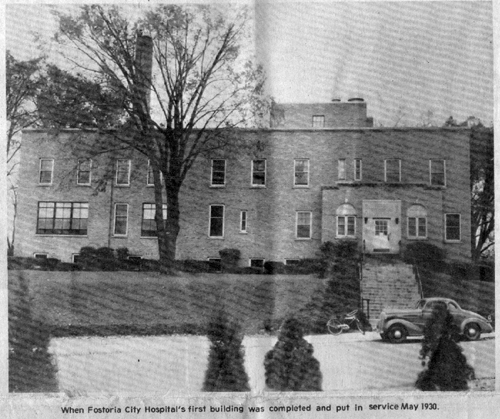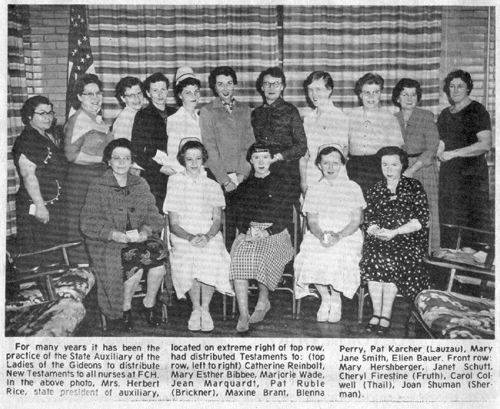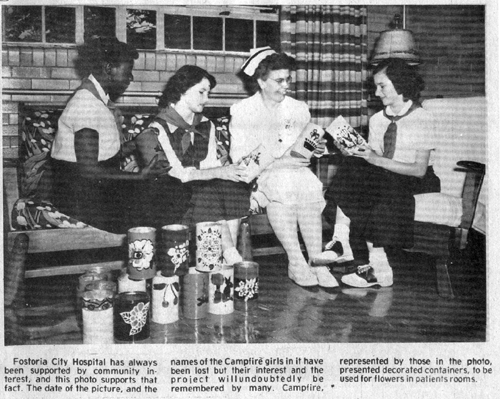May 15, 1980



Picture #1 – When Fostoria City Hospital’s first building was completed and put in service May 1930.
Picture #2 – Employees of the Hospital
Picture #3 – Employees of the Hospital
This is the 50th anniversary of Fostoria City Hospital, and it is time to retell the details of how it became a reality, so that the town’s younger generation and newcomers will know how much time, effort and money was spent for the initial structure before it was completed and ready for service May 1, 1930, and the succeeding plans and expenditures to provide the fine facilities that are available today.
Fostoria didn’t have hospital facilities until Dr. W.H. Leonard started a private hospital.
In December 1927, The Fostoria Academy of Medicine recognized the dire need for a local hospital and started to campaign to get one.
FOSTER WILL DESIGNATE SITE
At about that same time, according to a story that appeared in The Review in April 1927, Anne Foster’s will was revealed which bequeathed to the City of Fostoria the plot of ground which was part of the Foster estate, where the Municipal Building is today. The will stipulated that the land was to be used for a hospital and park.
As is sometimes the case in such matters, the question arose as to whether the land should be used as designated or whether there were ways to avoid the letter-of-the-law. Charles Strauch, a local attorney and also a councilman, was of the opinion that the land had to be used as the will directed. George M. Gray, head of Gray Printing Co. then, was strong for making a park there.
To make a long story short, by some means the will was finally settles, and the city legally inherited the land. Governor Charles Foster’s home, facing on West Tiffin Street was then demolished, as was the C.W. Foster home, facing Man Street, where The Review Times had been published before moving to East Center Street.
The plot of ground inherited by the city was all of the land where the Municipal building is now, except the commercial building at the corner of Tiffin and Main streets, which at one time had also been owned by the Foster Family.
CEMETERY HILL WAS CHOSEN
The inherited land was beautiful and became Foster park, thus satisfying part of the Foster will. And “Old Cemetery Hill” on Van Buren Street, dating back to 1832, and still un use until 1856, when the present Fountain Cemetery was surveyed and established, was selected as the hospital site.
Older readers will recall that the cemetery hill was often used for a play area, especially for sledding in winter, even though it was still recognized as a cemetery.
That’s the story of how Fostoria’s hospital facilities became located where they are today. Time has proven that the business district would not have been a good hospital site because of the many expansions that have taken place in the FCH facilities in the passing years, and the need for ample parking areas. the foresight of those who guided the decision has turned out to be correct, regardless of their reasons and personal preferences back then.
Before construction of a hospital on cemetery hill could begin it was necessary to transfer the buried bodies from the plot to Fountain Cemetery. The bodies had been interred for possibly 100 years by the early settlers of Risdon and Rome, before Fostoria was a town.
FIRST BUILDING COMPLETED IN 1930
Later, a bond issue for $75,000 to build the hospital was presented to Fostoria voters and carried by a 2 to 1 margin. A hospital board was appointed, consisting of Mayor C.W. Gibson, Dr. T.T. Rosendale, Ralph C. Brown, superintendent of Union Carbide; August Vogel, local tailor; and H.R. Geary Sr., one of Fostoria’s leading citizens. The board oversaw plans for the new facility and its construction.
Construction started in 1929 and was completed in 1930. It was opened for service on May 1, 1930, with Miss Mary Margorrum as Superintendent. H.W. Whitta was Fostoria’s mayor and C.C. Page was safety service director at that time.
The new hospital boasted 30 beds, but there was no maternity ward or special section for intensive care, or special treatment areas, as there are today. Living quarters were provided for the superintendent within the hospital, which meant she was available for consultation 24 hours a day.
During the first few years of operation the Fostoria City Hospital operated with total personnel of 12, including the superintendent, six registered nurses, one bookkeeper, one cook, one maid and one janitor.
By 1954, the personnel had grown to 75.
Today the increased use of the hospital requires a total employment of 265, 184 full-time and 81 part time people.
Whatever may have been lacking, as compared with today’s hospital, it was a grand step in the right direction, which ultimately led to the facilities available today, and certainly an improvement over Dr. Leonard’s privately owned hospital.
ENLARGEMENT COMPLETED IN 1939
The first enlargement to the hospital came in 1939, when a federal grant under the Works Program Administration resulted in 16 more beds for patients. Other changes at that time made it possible to have 14 private rooms, four semi-private rooms with eight beds, one war room with four beds, one labor room with two beds, an obstetrical section with 12 beds and two solariums with six beds.
Available records to not disclose what the enlarged facility cost.
Originally, operation of the hospital was the responsibility of the mayor and director of public service and safety. They appointed the superintendent and thus developed the local opinion that the appointment was political.
There had been some agitation to separate the management of the FCH from all political ties and get it in the hands of experienced hospital management personnel, with hopes of making it more efficient and profitable. Eventually a campaign to place a referendum on the ballot to lease the hospital from the city and operate it by a board of trustees and an administrator employed by the board. The Hospital Association was composed of Gordon Gray, president of Gray Printing Co.; Eldron Layton, president of First National Bank; and attorney John Gutknecht. Fifty-one local citizens initially became members of the association, and the referendum placed on the November 1961 election ballot passed.
HOSPITAL LEASED TO HOSPITAL ASSOCIATION
The management of the FCH thus passed to the new non-profit association on June 17, 1962, with Earl Wilkes employed as the first administrator under the new management. That was during the time when Phil Burbaker was mayor. Wilkes held the position until May 31, 1964, when he resigned.
Let’s back up in our retrospective view of the events which gave us our hospital of today.
In 1954, when Hal Stout, a previous mayor of Fostoria, was appointed as the FCH administrator, he began a campaign to interest the public in an expansion program, since the average daily patient enrollment had increased from 10 in 1930 to 43 in 1954. Today, the average daily census at FCH is 59. All facilities were taxed with the overload, as were the nurses, office help, cooks, and maintenance people. The interest in improving the facilities grew, and finally with $384,000 in Hill Burton federal funds, and $800,000 in city funds from income tax, a new wind was added to the building, consisting of three floors and renovation of the older portion.
ANOTHER EXPANSION CAME IN 1960
In 1960 when the new and renovated facilities were completed, the hospital had expanded from 46 to 80 beds, which consisted of 63 medical and surgical beds and 17 in the obstetrical area. It was during this building program that the main hospital entrance was relocated to sidewalk level, thus eliminating many steps.
After this building expansion program, the Fostoria Hospital Association assumed management of FCH.
In the years that followed the 1960 expansion, the growth of the outpatient and inpatient use of the hospital continued to climb, and the board of trustees and the administrator were plagued with the problem of further expansion. Many meetings involving the trustees, the expansion committee, hospital committee of city council, and the complete council were held.
Eventually, architect plans were developed, feasibility studies made and methods of financing studied. Agreement was finally reached to place on the May 1974 election ballot a suggested city income tax of 1/2 of 1 percent. The voters approved. The income tax over the years from 1974, provided $4,150,000 to pay for the expansion costs. Completion of the new construction and renovation was September 1976.
TODAY’S FACILITIES COMPLETED IN 1976
During the period beginning in 1968 and extending to completion of the 1976 expansion program, many new services were added and other improved, including physical therapy, respiratory therapy, E.E.G., social service, full time pharmacist and purchasing agent, full-time registered dietician, emergency room physician coverage, a five year management program for department heads, nursing supervisor and head nurses at Bowling Green State University, a hospital shared program to provide bio-medical engineering services and a shared hospital program to provide formal training for nursing personnel who work in the critical care unit.
In 1972, the hospital board of trustees approved participation in the licensed practical nurse program affiliation of Bowling Green. On acceptance with the Ohio State Board of Nursing and the Bowling Green School of Practical Nursing, the first class of students began their clinical work April 9, 1973. Six month April and October with approximately 12 students per class. Classes are supervised by an instructor from the school.
NEW FEATURES AND SERVICES
The efforts of the board of trustees since it has been responsible for operation of FCH with the help of the citizens of Fostoria, the medical staff, the Junior and Senior Hospital Guild now united into the Hospital Auxiliary, and many who assisted have resulted in the following accomplishments:
BEDS:
Critical care – 6
Obstetrical – 10
Pediatric – 6
Adult – 58
Bassinets – 12
NEW UNITS:
Intensive/coronary care
Obstetrical
Recovery Room
Telephone System
Large Emergency Generator
Air Conditioning of building
EXPANDED FACILITIES:
Emergency Room, radiology
Laboratory, Physical therapy
Pharmacy, Respiratory therapy
Medical records, Purchasing
Kitchen, cafeteria, lobby
LPN classroom, quite room (for use by bereaved families)
Central Receiving, Central Stores
This article would not be completed without naming and paying tribute to the many people, who in various capacities, have contributed in various ways to the success of FCH. There have been doctors, nurses, supervisors, donors and just plain people who have played a part in the hospitals success. Stories about many of these contained in other articles in this special section of The Review Times.
Credit for assistance in putting together this historical account go to Frances Bormuth, Mary Jane Smith, the Fostoria City Hospital, and Kaubisch Library.